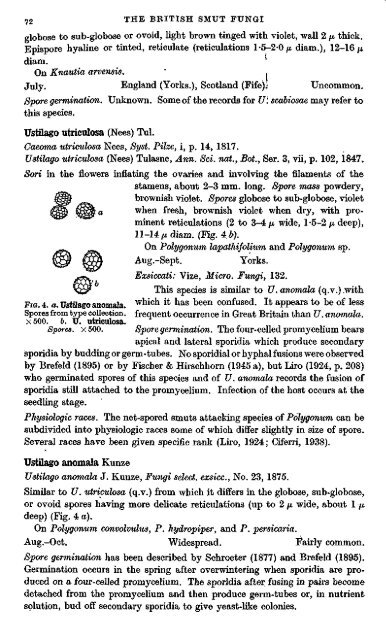nmm sP
nmm sP
nmm sP
You also want an ePaper? Increase the reach of your titles
YUMPU automatically turns print PDFs into web optimized ePapers that Google loves.
72 THE BRITISH SMUT FUNGI<br />
glotose to sub-globose or ovoid, light brown tinged with violet, wall 2 [J, thick.<br />
Epispore hyaline or tinted, reticulate (reticulations l'5-2-0 IJ. diam.), 12-16 ft<br />
diam.<br />
On Knautia arvensis. ' ,<br />
July. England (Yorks.), Scotland (Fife): Uncommon.<br />
Spore germination. Unknown. Some of the records for U: scabiosae may refer to<br />
this species.<br />
Ustilago utriculosa (Nees) Tul.<br />
Caeoma utriculosa Nees, Syst. Pilze, i, p. 14, 1817.<br />
Ustilago utriculosa (Nees) Tulasne, Ann. Sci. nat., Bot., Ser. 3, vii, p. 102, 1847.<br />
Sori in the flowers inflating the ovaries and involving the filaments of the<br />
stamens, about 2-3 mm. long. Spore mass powdery,<br />
brownish violet. Spores globose to sub-globose, violet<br />
when fresh, brownish violet when dry, with prominent<br />
reticulations (2 to 3-4 /Lt wide, 1-5-2 y. deep),<br />
11-14/^ diam. (Fig. 4:b).<br />
On Polygonum lapathifolium and Polygonum sp.<br />
Aug .-Sept. Yorks.<br />
Exsiccati: Vize, Micro. Fungi, 132.<br />
This species is similar to U. anomala (q.v.).with<br />
FIG. 4. o. Ustilago anomala. '^^^^^ i* has been confused. It appears to be of less<br />
Spores from type collection, frequent Occurrence in Great Britain than 17. anomala.<br />
x500. 6. U. utriculosa.<br />
Spores. x500. Spore germination. The four-celled promycehum bears<br />
apical and lateral sporidia which produce secondary<br />
sporidia by budding or germ-tubes. No sporidial or hyphal fusions were observed<br />
by Brefeld (1895) or by Fischer & Hirschhorn (1945 a), but Liro (1924, p. 208)<br />
who germinated spores of this species and of U. anomala records the fusion of<br />
sporidia still attached to the promycelium. Infection of the host occurs at the<br />
seedling stage.<br />
Physiologic races. The net-spored smuts attacking species of Polygonum can be<br />
subdivided into physiologic races some of which diifer slightly in size of spore.<br />
Several races have been given specific rank (Liro, 1924; Ciferri, 1938).<br />
Ustilago anomala Kunze<br />
Ustilago anomala J. Kunze, Fungi select, exsicc, No. 23, 1875.<br />
Similar to U. utriculosa (q.v.) from which it differs in the globose, sub-globose,<br />
or ovoid spores having more delicate reticulations (up to 2 /x wide, about 1 ft<br />
deep) (Fig. 4 a).<br />
On Polygonum convolvulus, P. hydropiper, and P. persicaria.<br />
Aug.-Oct. Widespread. Fairly common.<br />
Spore germination has been described by Schroeter (1877) and Brefeld (1895).<br />
Germination occurs in the spring after overwintering when sporidia are produced<br />
on a four-celled promycelium. The sporidia after fusing in pairs become<br />
detached from the promycehum and then produce germ-tubes or, in nutrient<br />
splution, bud off secondary sporidia to give yeast-like colonies.

















